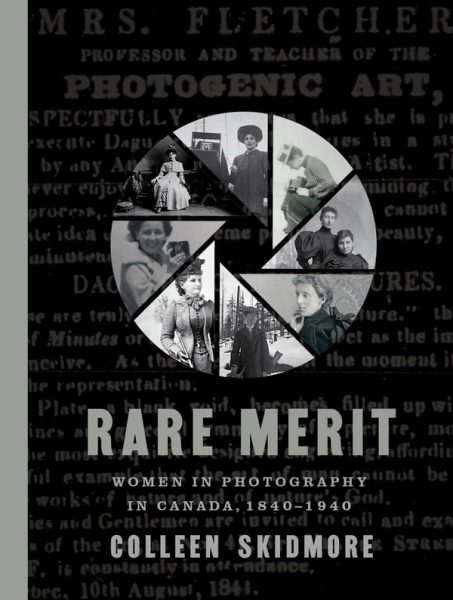
Rare Merit: Women in Photography in Canada, 1840-1940
Review By Nicholas Hrynyk
May 16, 2024
BC Studies no. 221 Spring 2024 | p. 255-256
Colleen Skidmore’s Rare Merit: Women in Photography in Canada, 1840-1940 provides a comprehensive survey of women’s contributions to Canadian photography between the years of 1840 and 1940. Skidmore argues that women played a crucial role in the development of photography as an art form and documentary medium during the 19th and early twentieth centuries. Skidmore’s meticulous research and engaging storytelling of women’s involvement in the capturing, production, marketing, and business of photography provides readers with a nuanced view of how women’s work in the industry intersected with technological advancements and changing social norms. Using business records, photographs, letters, and advertisements, among other sources, Skidmore delves into the lives and businesses of these previously forgotten women photographers. As such, Rare Merit paints a vivid picture of the lives and work of these female pioneers, simultaneously challenging the assumption of women’s absence in an otherwise male-dominated field and connecting their work with the cultural imaginings of Canada.
Skidmore structures her book chronologically using the gradual evolution of photograph technology and women’s changing interests and relationship to photography as markers. While doing so, Skidmore thoughtfully introduces photographers, such as Mrs. Fletcher from Pictou, Nova Scotia, who is regarded as North America’s first professional woman photographer. Skidmore opens Rare Merit with a look at Fletcher’s life, highlighting the importance of visibility for securing a place for women in the history of photography, as well as illustrating the ways in which women advertised their work, taught their craft to other women, and helped develop photography as an art and business. She also considers the work of other notable women photographers, including Élide L’Heureux Livernois of Quebec City, Hannah Maynard of British Columbia, and Geraldine Moodie of the western prairies and eastern Arctic. These women had studios of their own, and their innovations in photography are presented by Skidmore as integral to shaping perceptions of Canadian history, culture, and identity.
Thus, Rare Merit serves the secondary task of conveying the importance and power of photography in shaping understandings of Canada as a newly formed nation-state. In her words, photography “enabled colonial citizens of the newly confederated Canada to imagine and shape a sense of their young country, its geography, its people, its heritage, and its histories” (37). For instance, Skidmore describes Geraldine Moodie as having “photographically assembled and sorted individuals into social and cultural categories, as imagined and needed by her own culture, just as she and other studio photographers did with portrait clients in the south, though long-established European visual codes of dress, gesture, pose, props, and faux background settings” (137). While the book stresses the importance of photography in establishing these Eurocentric ideas in Canada, Rare Merit would have benefitted this line of inquiry by situating these women as agents of empire in the newly formed nation of Canada. Nevertheless, it is the exploration of how women photographers negotiated their identities and roles in a rapidly changing society that proves to be one of the most compelling facets of Rare Merit. Indeed, Skidmore demonstrates that these women used photography not only as a means of artistic expression but as a tool for social commentary and an opportunity to contest gendered restrictions of the period.
Rare Merit is an insightful survey and pleasurable journey into an often-overlooked aspect of Canadian photography history. Skidmore’s meticulous research and engaging narrative make this book a valuable contribution to the field and a must-read for anyone interested in photography, women’s history, or Canadian studies. Through her exploration of these pioneering women, Skidmore has provided a compelling glimpse into a rich and diverse chapter of Canadian cultural history.
Publication Information
Skidmore, Colleen. Rare Merit: Women in Photography in Canada, 1840-1940. Vancouver: University of British Columbia Press. 2022. 368 pp. $39.95 paper.
